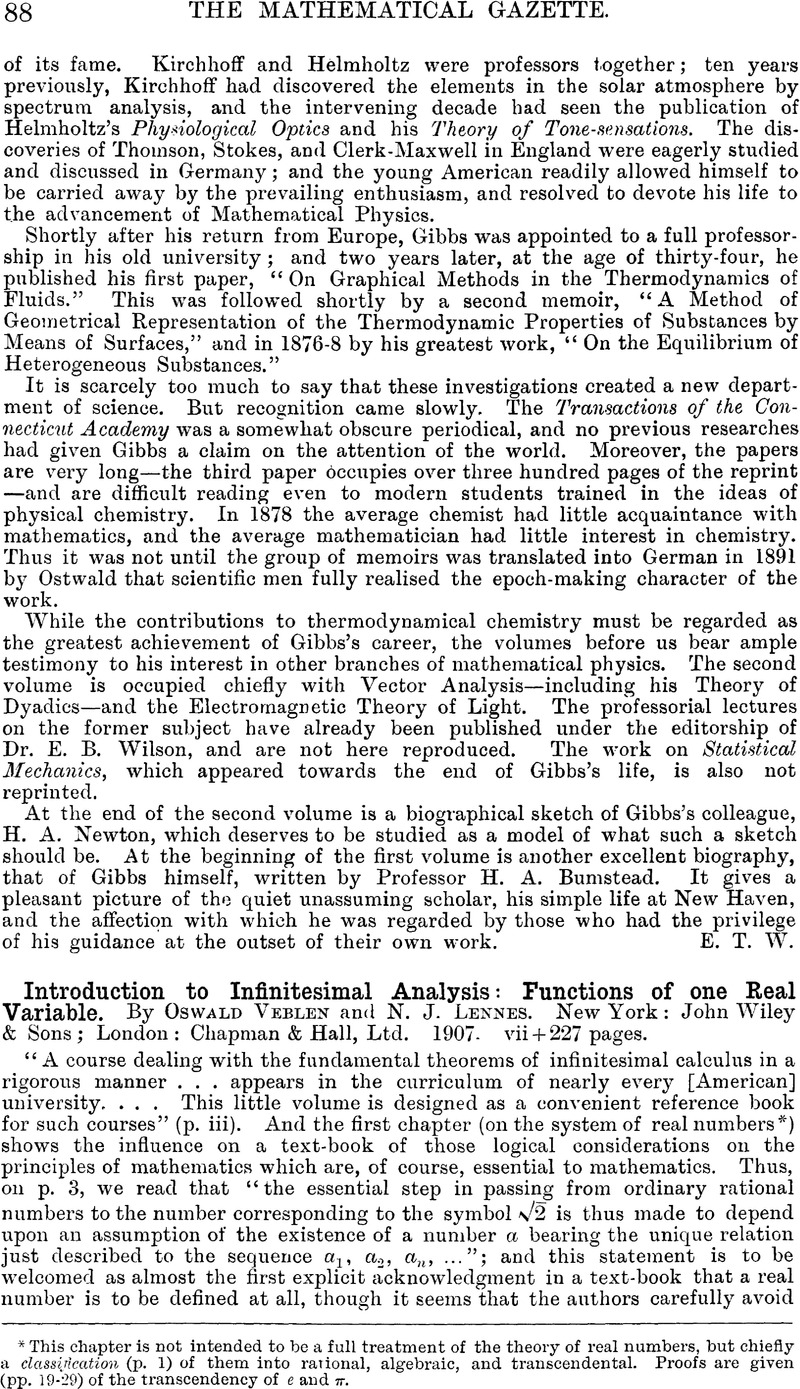No CrossRef data available.
Article contents
Introduction to Infinitesimal Analysis: Functions of one Real Variable. By Oswald Veblen and N. J. Lennes. New York: John Wiley & Sons; London: Chapman & Hall, Ltd.1907. vii+227 pages.
Review products
Published online by Cambridge University Press: 03 November 2016
Abstract

- Type
- Reviews
- Information
- Copyright
- Copyright © Mathematical Association 1907
References
page no 88 note * This Chapter is not intended to be a full treatment of the treory of real numbres, but chiefiy a classification (p. 1) of them into retional, algebraic, and transcendental. Proofs are given (pp.19-29) of the transcendency of e and π.
page no 89 note * The authors assume (p. 11) the existence and defining properties of the positive integers by-set of axioms, and show, by the example of the integer-pairs [m, n], where [mk, nk] (k being an integer) “is regarded as the same as [m, k],” and ‘multiplication’ and ‘addition’of pairs are defined by certain equations, “that no contradiction will be introduced by adding a further axiom to the effect that besides the integers there are numbers, called fractions, such that in the extended system division is possible.”
In the first place, we cannot, unless we re-define ‘equality,’ assert that [m, n] = [mk, nk], for this is not an identity. And re-definition of ‘equality’ is unnecessary, for, as Frege remarked ( cf.Couturat, , Les principes des mathématiques, Paris, 1905, p. 49 Google Scholar), mathematical equality means logical identity. Secondly, the example shows only that there is a system of pairs, which does not include the integers, since the pair [m, 1] cannot be m (cf. this Gazette, May, 1906, p. 315), but includes a part of pairs in which the second term is 1, and which have a one-one correspondence with the integers, in which ‘division’ (which is quite different in concept to the division of integers, but was suggested by it) is always possible. The authors rightly denote the ‘multiplication’ and ‘addition’ of pairs by new signs. Thus the axiom of the existence of fractions with the integers is unjustified; while a not very great alteration affords us a definition of fractions (a classes of couples), and renders an ‘axiom’ unnecessary.
Much the same remarks apply to the axiomatic introduction (pp. 12-13) of negative, real, an complex numbers; while the (Huntington’s) definition of a real number system by a set of postulates (pp. 13-15) is, like Hilbert’s analogous attempts, subject to logical objections (c Couturat, op. cit., pp. 40-42, 57-58; Frege, Jahresber. d. deutsch. Math.-Ver., 1903).
I incline more and more to the view that, for beginners, a geometrical introduction of ‘number’ (in a wider sense) is advisable, and this seems to be suggested by our authors in the note on p. 30.
Though our authors deserve our thanks for not calling a number a sign, they define (p. 44) ‘Variable’ as a symbol (cf. this Gazette, May, 1906, p. 315).
page no 89 note † See Veblen, , Bull. Amer. Math. Soc. (2), x., 1904, pp. 436–439 CrossRefGoogle Scholar.
page no 89 note ‡ The axiom in Dedekind’s work is geometrical; he proves the continuity of the real number system. But his process is equivalent to the defining of real numbers by an axiom of continuite (as is done on pp. 3-7).
page no 89 note § See my paper in the Mess. of Math., 1906, pp. 61-69. In this connexion, it should be remarke that the ‘the’ on our author’s p. 33 (1. 4 from bottom) should be ‘a.’
page no 89 note ‖ Math. Ann., Bd. lix., 1904, pp. 514-516.
page no 89 note ** A member of the class of limits of f(x) when x approaches a limit-point a. Since this class always has at least one member (p. 61), the existence or non-existence of the limit of f(x) whe x approaches a means, respectively, that the class has only one member or more than on member.
page no 89 note †† The development of the remark on the uniform continuity of ![]() and on a resulting possifr definition of a
x
(pp. 96-97), is especially illuminating for a student.
and on a resulting possifr definition of a
x
(pp. 96-97), is especially illuminating for a student.
page no 90 note * There might have been very suitably some discussion on the conception of uniform differentiability and its relations with the continuity of f′ (x), on p. 133. This is very necessary for an adequate appreciation of Goursat’s proof of Cauchy’s theorem in complex function-theory.
page no 90 note † The development of the theory of limits for many-valued functions also gives certain advantages in the treatment of the definite integral (pp. 153-154).




